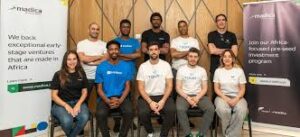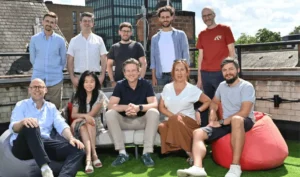In an era where digital transformation has made software the backbone of global commerce, a sobering reality confronts the technology industry: software failures cost businesses $400 billion globally in 2024 alone. London-based startup Phoebe has emerged with a $17 million seed funding round led by GV (Google Ventures) and Cherry Ventures, positioning itself to tackle what founders Matt Henderson and James Summerfield call the missing piece of software infrastructure—an intelligent immune system that preemptively identifies and resolves system failures.
The funding represents one of the largest seed rounds for a UK-based company in 2025, reflecting investor confidence in both the founding team’s track record and the enormous market opportunity created by software reliability challenges. The global artificial intelligence market, valued at $279.22 billion in 2024, is projected to grow at a CAGR of 35.9% through 2030, with specialized AI applications for infrastructure and operations representing a rapidly expanding subset of this growth.
According to Cisco’s research, 46% of network outages result in significant revenue loss, while recent industry data suggests that software developers spend up to 30% of their time reactively addressing bugs and errors rather than building new features. This productivity drain, combined with the exponential growth in software complexity and deployment frequency, has created a critical market gap that Phoebe aims to fill.
The Founders: From Stripe Europe to Software Immune Systems
Henderson and Summerfield bring exceptional credibility to the software reliability challenge, having previously served as CEO and Chief Information Officer of Stripe Europe respectively. Their experience scaling Stripe’s European operations provided intimate familiarity with the operational challenges of maintaining high-availability financial services infrastructure at global scale.
The duo’s entrepreneurial track record includes Rangespan, which they sold to Google a decade earlier, demonstrating their ability to build companies that attract acquisition interest from major technology platforms. This background likely contributed to GV’s investment decision, as Google Ventures can leverage internal knowledge of the founders’ previous work and capabilities.
Their motivation for founding Phoebe stems from direct experience with the operational burden that software reliability issues place on engineering teams. “High-severity incidents can make or break big customer relationships, and numerous smaller problems drain engineering productivity,” Henderson explains. “Software monitoring tools exist, but they aren’t very intelligent and require people to spend a lot of time working out what is wrong and what to do about it.”
This firsthand understanding of the problem space, combined with deep experience in high-stakes software operations, positions Phoebe’s founding team uniquely to address enterprise software reliability challenges.
Technology Architecture: AI Agents as Software Antibodies
Phoebe’s approach centers on deploying “swarms” of AI agents that continuously monitor software systems and respond autonomously to detected issues. Unlike traditional monitoring tools that generate alerts requiring human interpretation and response, Phoebe’s platform aims to understand context, diagnose problems, and implement fixes without human intervention.
The company’s AI agents sift through siloed data across different systems to identify errors in real time, claiming to reduce resolution time by up to 90% compared to manual troubleshooting approaches. This dramatic improvement stems from the agents’ ability to correlate information across multiple data sources, understand system dependencies, and apply learned patterns from previous incidents to new problems.
The “immune system” metaphor reflects the platform’s design philosophy: just as biological immune systems identify and neutralize threats automatically, Phoebe’s AI agents are designed to detect and resolve software issues before they impact users or business operations. This proactive approach represents a fundamental shift from reactive incident response toward predictive system maintenance.
The technical complexity of this approach cannot be understated. Effective software troubleshooting requires understanding application architecture, infrastructure dependencies, data flow patterns, and business impact—knowledge that traditionally resides in the minds of senior engineers with years of system-specific experience.
Market Dynamics: The Growing Observability and AIOps Opportunity
The AI in Observability market is valued at $1.4 billion and is expected to reach $10.7 billion by 2033, growing at a compound annual growth rate of 22.5%. The broader infrastructure monitoring market reached $5.59 billion in 2024 and is predicted to reach $15.70 billion by 2034 with a CAGR of 10.88%.
These market projections reflect the increasing complexity of modern software systems, which often involve microservices architectures, cloud-native deployments, and integration with multiple third-party services. Each additional component increases the potential points of failure while making root cause analysis more difficult for human operators.
The shift toward DevOps and continuous deployment practices has further accelerated the need for intelligent monitoring and response systems. Organizations deploying code multiple times per day cannot afford manual incident response processes that take hours to identify and resolve issues.
Traditional monitoring and observability tools—including Datadog, New Relic, and Splunk—have focused primarily on data collection and visualization, leaving analysis and response largely to human operators. Phoebe’s AI-native approach represents the next evolution in this technology stack, potentially displacing or complementing existing tools with automated intelligence.
Customer Validation: Early Success with Critical Infrastructure
Phoebe has secured early customers including Trainline, the UK’s rail booking platform, which provides critical validation for the company’s approach. Rail booking systems represent particularly demanding reliability requirements, as outages directly impact public transportation access and customer satisfaction.
Jay Davies, head of engineering for reliability and operations at Trainline, reported that Phoebe had “already had a real impact on how we investigate and remediate incidents.” The specific claim that “work that used to take us hours to piece together can now take minutes” suggests meaningful productivity improvements for engineering teams dealing with incident response.
This early customer success with a high-profile, mission-critical application demonstrates that Phoebe’s technology can deliver value in demanding production environments. Trainline’s endorsement also serves as a reference case for sales conversations with other enterprises facing similar operational challenges.
The choice to work with customers operating critical infrastructure reflects strategic positioning around high-value use cases where software reliability directly impacts business revenue and customer satisfaction. This focus on enterprise customers with substantial operational budgets aligns with Phoebe’s funding requirements and growth aspirations.
Competitive Landscape: AI-Native vs. Traditional Monitoring
The software monitoring and observability space includes both established enterprise vendors and emerging AI-focused startups. Traditional players like Datadog, New Relic, Splunk, and Dynatrace have built substantial businesses around data collection, correlation, and visualization but generally require human operators to interpret alerts and implement responses.
Emerging AIOps (Artificial Intelligence for IT Operations) companies like Moogsoft, BigPanda, and PagerDuty have begun incorporating machine learning for alert correlation and incident prioritization, but most still rely heavily on human expertise for problem resolution.
Phoebe’s positioning as a software “immune system” suggests a more autonomous approach than current market leaders, potentially representing a generational shift toward fully automated incident response. However, the company faces the challenge of proving that AI agents can reliably handle the complex reasoning required for production system troubleshooting.
The success of this approach will depend on Phoebe’s ability to build AI models that understand system behavior patterns, accurately diagnose complex failure modes, and implement fixes without creating additional problems. This requires not just machine learning expertise but deep understanding of software architecture, infrastructure management, and operational best practices.
Investment Thesis: Why Google Ventures and Cherry Ventures Backed Phoebe
GV’s investment decision reflects both strategic and financial considerations. Roni Hiranand, a GV executive, explained the investment rationale: “AI has transformed how code is written, but software reliability has not kept pace. Phoebe is building a missing layer of contextual intelligence that can help both human and AI engineers avoid software failures.”
This perspective highlights a key market insight: while AI tools for software development (like GitHub Copilot and similar code generation platforms) have gained rapid adoption, the operational side of software management remains largely manual. Phoebe addresses this imbalance by applying AI to the post-deployment phase of software lifecycle management.
For Google, this investment also provides strategic intelligence about enterprise AI adoption patterns and potential integration opportunities with Google Cloud Platform services. GV’s portfolio strategy often includes investments that could eventually become acquisition candidates or strategic partners for Google’s broader technology ecosystem.
Cherry Ventures, a European venture capital firm focused on early-stage technology companies, brings complementary expertise in scaling enterprise software companies across European markets. Their investment suggests confidence in Phoebe’s ability to expand beyond initial UK customers to serve the broader European enterprise market.
The $17 million seed round size reflects the capital requirements for building enterprise-grade AI systems while supporting sales and marketing efforts targeting large enterprise customers. This funding level enables Phoebe to hire specialized talent in AI/ML, enterprise software development, and customer success while investing in the compute infrastructure necessary for training and deploying AI agents at scale.
Technical Challenges: The Complexity of Autonomous System Repair
Building effective AI agents for software troubleshooting presents numerous technical challenges that extend beyond traditional machine learning applications. Effective troubleshooting requires understanding causal relationships between system components, distinguishing correlation from causation in performance data, and predicting the downstream effects of potential remediation actions.
Software systems exhibit complex emergent behaviors that can be difficult to model algorithmically. A database performance issue might stem from application code inefficiencies, infrastructure resource constraints, network connectivity problems, or external service dependencies. Identifying the root cause often requires combining quantitative performance metrics with qualitative understanding of system architecture and business logic.
The “swarms” approach mentioned in Phoebe’s positioning suggests a multi-agent system where different AI agents specialize in different aspects of system monitoring and troubleshooting. This architecture could provide redundancy and specialized expertise but requires sophisticated coordination mechanisms to prevent conflicting actions or cascading failures.
Perhaps most critically, autonomous system repair requires extremely high reliability standards. An AI agent that occasionally misdiagnoses problems or implements inappropriate fixes could cause more damage than the original issues it was designed to solve. This creates a significant validation and testing burden for Phoebe’s product development process.
Market Entry Strategy: Enterprise Sales and Platform Partnerships
Phoebe’s early customer success with Trainline suggests a direct enterprise sales approach focused on companies operating mission-critical software systems. This strategy aligns with the company’s high-value positioning but requires building specialized sales and customer success capabilities for complex enterprise buying processes.
The enterprise sales model typically involves longer sales cycles but higher deal values and customer lifetime value. For a company like Phoebe, successful enterprise customers can serve as reference accounts that accelerate future sales while providing valuable feedback for product development.
Platform partnerships with cloud providers, monitoring tool vendors, or systems integrators could provide distribution channels and technical integration opportunities. Phoebe’s AI agents likely need access to system metrics, logs, and configuration data that existing monitoring platforms already collect, suggesting potential partnership or integration opportunities.
The company’s positioning as a “missing layer” in existing infrastructure stacks suggests a complementary rather than replacement strategy relative to current monitoring tools. This approach could reduce customer switching costs while enabling gradual adoption of AI-powered capabilities.
International Expansion: UK as European Beachhead
London’s position as a European technology hub provides Phoebe with access to both local enterprise customers and international expansion opportunities. The UK’s mature enterprise software market offers sophisticated early adopters who can provide valuable product feedback while serving as reference customers for broader European expansion.
Brexit has created some challenges for UK technology companies expanding into European markets, but enterprise software sales are generally less affected by regulatory barriers than other sectors. Phoebe’s AI-powered approach could provide differentiation in European markets where traditional monitoring vendors have established relationships but may lack advanced AI capabilities.
The global nature of software infrastructure challenges suggests significant international market opportunities beyond Europe. However, enterprise software expansion typically requires local sales presence, partnership development, and adaptation to regional compliance requirements.
Financial Projections and Business Model Implications
While Phoebe has not disclosed specific pricing models or revenue projections, the enterprise software monitoring market typically involves subscription-based pricing models based on factors like data volume, infrastructure scale, or feature tiers. AI-powered capabilities could command premium pricing relative to traditional monitoring tools.
The $17 million seed funding suggests aggressive growth expectations and substantial operating expenses for team building, technology development, and customer acquisition. Enterprise software companies typically require significant upfront investment in sales, marketing, and customer success capabilities before achieving sustainable unit economics.
Successful enterprise software companies often achieve gross margins above 80% once they reach scale, but require substantial initial investment in product development and market validation. Phoebe’s AI-native approach could provide competitive advantages but also increases technical development complexity and operational costs.
The path to additional funding rounds will likely depend on demonstrating measurable customer success, expanding the customer base beyond early adopters, and proving the scalability of the AI agent approach across diverse enterprise environments.
Regulatory and Compliance Considerations
AI systems operating in production enterprise environments face increasing regulatory scrutiny around algorithmic decision-making, data privacy, and system security. Phoebe’s AI agents will need to operate within various compliance frameworks including GDPR, SOX, HIPAA, and industry-specific regulations depending on customer requirements.
The autonomous nature of Phoebe’s AI agents creates additional complexity around audit trails, explainability, and accountability for system changes. Enterprise customers often require detailed logging and approval processes for production system modifications, which could limit the degree of automation possible in highly regulated environments.
Building trust with enterprise security teams will require demonstrating that AI agents operate within defined parameters, maintain appropriate access controls, and provide transparent reporting on all actions taken. This requirement could influence product architecture and implementation approaches.
Competitive Response and Market Evolution
Phoebe’s success will likely prompt competitive responses from both traditional monitoring vendors and new AI-focused entrants. Established players with existing customer relationships and data collection capabilities could develop competing AI features, while new startups might pursue similar autonomous troubleshooting approaches.
The pace of competitive response will depend partly on customer adoption rates and the demonstrable value that AI agents provide relative to human-driven troubleshooting processes. Strong early customer success could establish Phoebe’s position before competitors can develop comparable capabilities.
However, the substantial technical barriers to building effective autonomous troubleshooting systems suggest that competitive advantages might be sustainable for companies that successfully solve the core technical challenges. Deep learning models trained on diverse system failure patterns could create network effects that strengthen over time.
Future Development Roadmap and Scaling Challenges
Phoebe’s technology roadmap likely includes expanding AI agent capabilities to handle more complex failure scenarios, integrating with additional monitoring and infrastructure platforms, and developing industry-specific expertise for vertical markets with specialized requirements.
Scaling AI agent deployment across diverse enterprise environments will require sophisticated model management capabilities, automated training pipelines, and robust testing frameworks. Each customer environment presents unique system configurations, architectural patterns, and failure modes that AI agents must learn to handle effectively.
The company will need to balance automation capabilities with human oversight requirements, providing enterprise customers with appropriate control and visibility into AI agent actions. This balance will likely vary across different customer segments and use cases.
Strategic Implications: The Future of Software Operations
Phoebe’s approach represents a potential inflection point in software operations, moving from reactive incident response toward predictive system maintenance. Success could catalyze broader adoption of AI-powered infrastructure management while demonstrating the viability of autonomous system repair.
The implications extend beyond cost savings and efficiency improvements to fundamental questions about the role of human expertise in technology operations. If AI agents can effectively handle routine troubleshooting tasks, human operators could focus on higher-value activities like architecture design, capacity planning, and strategic technology decisions.
However, the success of this vision depends on proving that AI systems can reliably handle the complex reasoning and contextual understanding required for production system management. Early customer results with Trainline provide encouraging signals, but broader market validation will require demonstrating success across diverse enterprise environments and use cases.








